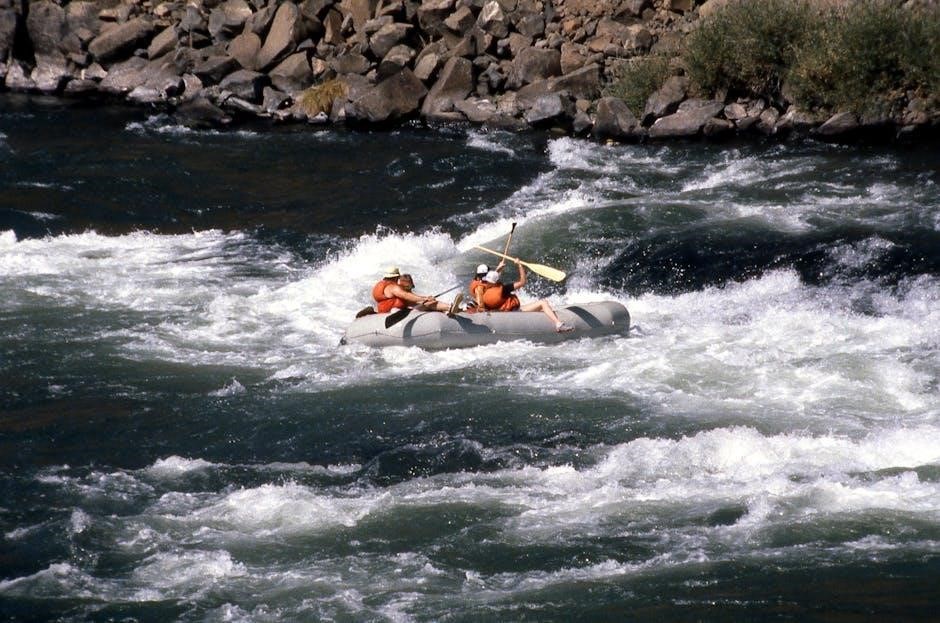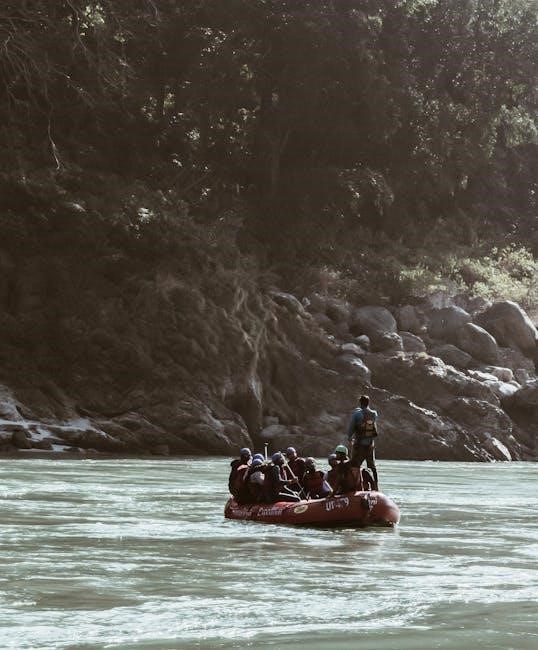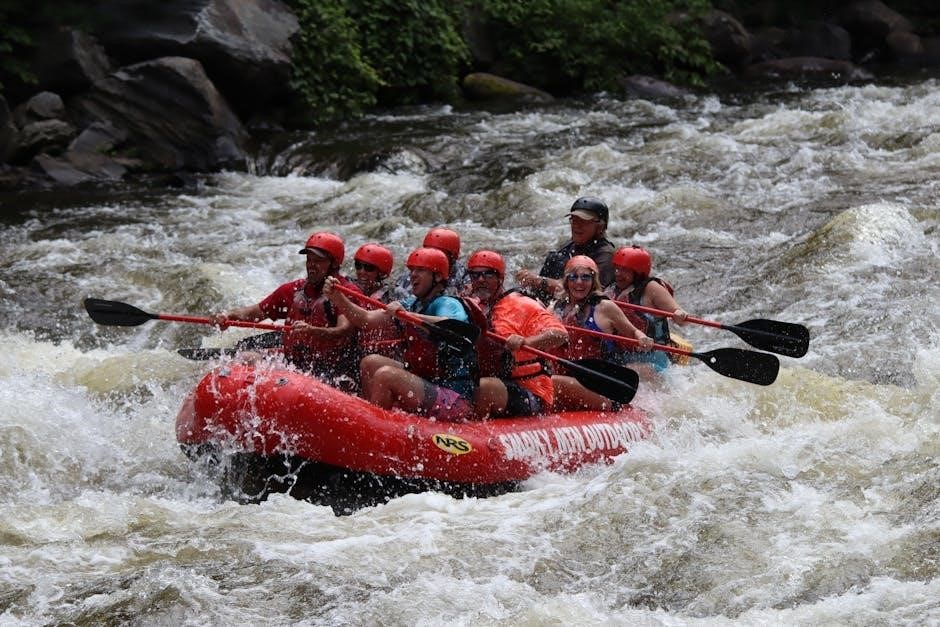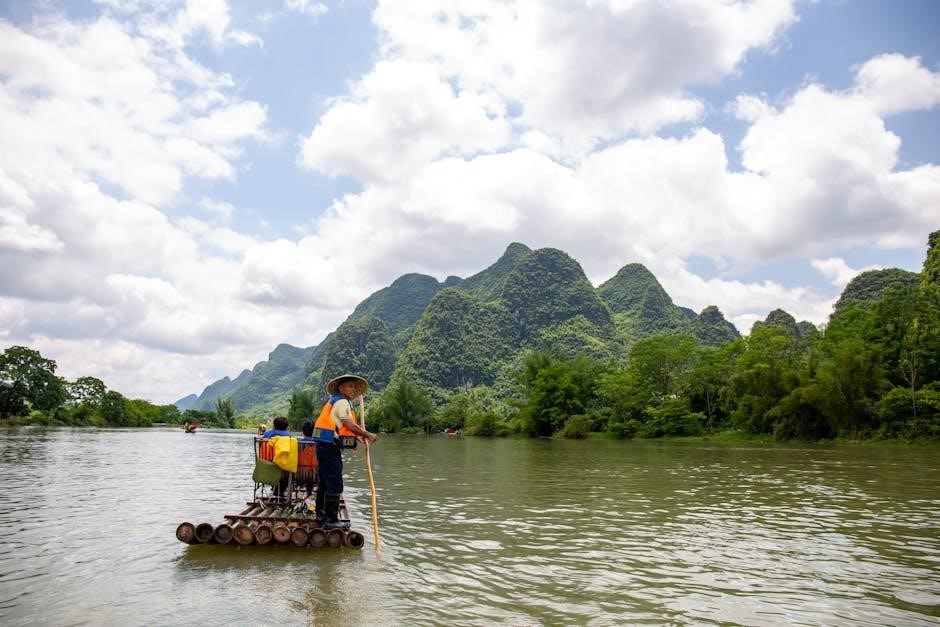Tipping rafting guides is a customary way to express appreciation for their expertise, safety measures, and effort in ensuring a memorable experience. It is expected in the service industry and reflects satisfaction with the quality of service provided.
1.1. Understanding the Importance of Tipping in the Service Industry
Tipping is a widely accepted social norm in the service industry, reflecting customer satisfaction and appreciation for exceptional service. In rafting, guides rely on tips as a significant part of their income, as their earnings often depend on the quality of their performance. Tipping demonstrates recognition of the guide’s expertise, effort, and ability to ensure a safe and enjoyable experience. It also serves as a way to acknowledge their role in creating memorable moments during the trip. While tipping is voluntary, it is expected in most service-based industries, especially in roles where staff directly interact with clients to enhance their experience. Tipping standards vary, but they universally convey gratitude for outstanding service.

1.2. Why Tipping is Customary for Rafting Guides
Tipping is customary for rafting guides because they provide specialized skills, ensure safety, and enhance the overall experience. Guides often rely on tips as a significant part of their income, as their earnings may vary based on trip frequency and duration. Their expertise in navigating rapids, teaching techniques, and managing safety protocols directly impacts the quality of the adventure. Tipping acknowledges their hard work, dedication, and ability to create a memorable and enjoyable journey. It is a way to express gratitude for their professionalism and the effort they put into ensuring a safe and fun experience for all participants. This practice aligns with broader service industry norms, where tips are expected for exceptional service.

Factors Influencing the Tip Amount
The tip amount for rafting guides is influenced by service quality, trip duration, group size, and the difficulty level of the rapids, ensuring fair compensation for their efforts.
2.1. Quality of Service Provided by the Guide
The quality of service is a key factor in determining the tip amount. Guides who provide exceptional leadership, safety, and engagement deserve higher tips. If the guide ensures a smooth, enjoyable, and safe experience, tipping generously is appropriate. Conversely, if the service is subpar, the tip may be adjusted accordingly. Guides who go above and beyond, such as sharing knowledge about the environment or handling emergencies skillfully, should be recognized with a larger gratuity. The tip reflects the guide’s professionalism and the overall satisfaction of the rafting experience.
2.2. Duration of the Rafting Trip
The duration of the rafting trip significantly influences the tip amount. Half-day trips typically warrant a smaller tip, such as $3-5 per person, while full-day trips often see tips of $5-7 per person. For multi-day expeditions, the tip increases to $10-15 per person, reflecting the extended time and effort required. Longer trips involve more resources, guiding, and often additional services like meals and camping setups. The tip should align with the length and complexity of the trip, ensuring fair compensation for the guide’s extended involvement and dedication. Considering the duration helps in determining a reasonable and appreciative gratuity for the guide’s services.

2.3. Group Size and Number of Participants
Group size and the number of participants play a role in determining the tip amount for rafting guides. Larger groups often require more coordination and effort, which may justify a higher tip. For example, a group of six may tip a total of $30-42 for a full-day trip, based on $5-7 per person. Smaller groups, such as two people, might tip $10-14 for the same duration. The tip should reflect the guide’s ability to manage the group effectively and ensure everyone’s safety and enjoyment. The per-person rate helps distribute the tip fairly, considering the overall experience and service quality provided by the guide.
2.4. Difficulty Level of the Rapids
The difficulty level of the rapids significantly influences the tip amount for rafting guides. More challenging rapids require greater skill, physical effort, and focus from the guide to ensure safety and an exciting experience. Guides navigating Class IV or V rapids, for instance, may warrant a higher tip, reflecting their expertise and the increased risk involved. On average, an additional $5-10 per person is recommended for high-difficulty trips, as the guide’s role becomes more critical. This adjustment ensures that the tip accurately represents the guide’s contribution to the success and enjoyment of the adventure, acknowledging the added complexity and danger of the route.
Industry Standards for Rafting Guide Tipping
Industry standards suggest tipping rafting guides 10-20% of the total trip cost, reflecting service quality and trip duration. This range ensures fair compensation for their expertise and efforts.
3.1. General Percentage Guidelines (10-20% of Total Cost)
Tipping rafting guides typically ranges between 10% to 20% of the total trip cost. This percentage-based approach ensures that the tip reflects the overall expense and service quality. For instance, if a half-day trip costs $100 per person, a tip of $10 to $20 per person is appropriate. Similarly, for a full-day trip costing $150, tipping $15 to $30 per person aligns with industry standards. This guideline provides a clear benchmark, allowing guests to show appreciation for their guide’s expertise, safety measures, and effort in creating a memorable experience. Adjustments can be made based on individual satisfaction and budget constraints.
3.2. Per Person Tipping Rates for Different Trip Lengths
For half-day rafting trips, a tip of $3 to $5 per person is customary, while full-day trips typically warrant $5 to $7 per person. Multi-day excursions, lasting two or more days, generally call for $10 to $15 per person. These rates are designed to reflect the varying levels of effort and involvement from guides based on trip duration. Extended expeditions, such as multi-day river journeys, may see higher tips, often ranging from $50 to $100 per guide, depending on the length and complexity of the trip. These per-person guidelines provide a straightforward way to express gratitude for the guide’s expertise and dedication to ensuring a safe and enjoyable adventure.
3.3. Recommended Tips for Multi-Day Expeditions
Multi-day rafting expeditions often require a higher level of gratuity due to the extended nature of the trip and the increased effort from guides. The recommended tip for such adventures typically ranges from $10 to $15 per person daily, totaling $20 to $50 or more for a three-day trip. For longer expeditions, such as those spanning a week or more, guests often tip $50 to $100 per guide, reflecting the guides’ continuous support and dedication. These amounts are suggested guidelines and should be adjusted based on the quality of service and personal satisfaction. Tipping can be given directly to the guide or pooled among the group and distributed equally, ensuring that each member of the team is recognized for their contributions.


Tipping Guidelines Based on Trip Duration
Tipping varies by trip length: half-day trips typically receive $3-5 per person, full-day trips $5-7, and multi-day trips $10-15 per person. Extended expeditions may see $50-100 per guide.
4.1. Half-Day Trips: $3-5 Per Person
For half-day rafting trips, a tip of $3 to $5 per person is considered standard. This amount reflects the shorter duration of the trip and the guide’s role in ensuring a safe and enjoyable experience. The tip is a way to acknowledge the guide’s expertise, effort, and contribution to the success of the outing. It is customary to base the tip on the quality of service, with $3 being a baseline for adequate service and $5 for exceptional service. This range aligns with general tipping practices in the service industry, where guides rely on gratuity as part of their compensation. Tipping is discretionary but appreciated, especially if the guide goes above and beyond to make the trip memorable;
4.2. Full-Day Trips: $5-7 Per Person
For full-day rafting trips, tipping $5 to $7 per person is recommended. This range accounts for the extended time spent on the water and the increased effort required from guides to manage a longer excursion. The tip should reflect the guide’s performance, with $5 for good service and up to $7 for outstanding experiences. Full-day trips often involve more complex logistics, meal coordination, and personalized attention, making the higher tip range appropriate. Tipping is a standard practice to show appreciation for the guide’s dedication and expertise. It is customary to base the tip on individual satisfaction and the overall quality of the experience provided throughout the day.
4.3. Multi-Day Trips: $10-15 Per Person
For multi-day rafting trips, a tip of $10 to $15 per person is customary. This range reflects the extended duration and the increased responsibilities of guides, including camp setup, meal preparation, and ensuring safety over multiple days. The tip should be based on the quality of service, with $10 for standard service and up to $15 for exceptional experiences. Multi-day trips involve more personalized attention and efforts from guides, making the higher tip range appropriate. Tipping is a standard practice to acknowledge the guide’s hard work and dedication throughout the extended excursion. It is customary to base the tip on individual satisfaction and the overall quality of the experience provided during the trip.
4.4. Extended Expeditions: $50-100 Per Guide
For extended rafting expeditions, a tip of $50 to $100 per guide is considered appropriate. These longer trips often involve multiple guides, and the tip should reflect their dedication, expertise, and the extensive efforts required to manage the logistics of the expedition. The higher end of the range is suitable for exceptional service, particularly when guides go above and beyond to ensure a safe and enjoyable experience. Extended expeditions typically involve more complex planning, meal preparation, and camp management, making the higher tip range a fitting acknowledgement of the guides’ hard work. Tipping each guide individually within this range ensures they are fairly compensated for their efforts during the prolonged adventure.

Tipping Etiquette and Best Practices
Tipping etiquette for rafting guides involves showing appreciation through cash or envelope contributions, reflecting the quality of service, and can be given directly or via operators.
5.1. Cash Tips vs. Envelope Contributions
When deciding how to tip your rafting guide, cash tips are the most common method, offering immediate appreciation. However, many tour operators provide envelopes for contributions, allowing guests to leave a note along with their gratuity. This method ensures privacy and can be especially useful for group collections. Cash is often preferred, but envelopes are a thoughtful alternative, giving guests the opportunity to personalize their thanks. Both methods are acceptable, and the choice depends on personal preference and convenience. Ensuring the tip reflects satisfaction with the service is key, regardless of the method chosen.
5.2. When to Tip: During or After the Trip
The ideal time to tip a rafting guide is at the end of the trip, allowing you to reflect on the entire experience. This ensures your gratuity accurately represents your satisfaction. However, on multi-day trips, some guests prefer to tip during the trip as a gesture of appreciation for the guide’s ongoing efforts. Tipping after the trip is more common, as it provides a clear opportunity to assess the service quality. For extended expeditions, tips are often collected on the final evening, giving guests time to consider their experience. Regardless of timing, the key is to ensure the tip is given thoughtfully and in line with the service received.
5.3. How to Tip: Directly to the Guide or Through the Tour Operator
Tipping can be done directly to the guide or through the tour operator, offering flexibility based on preference. Direct tips allow personal acknowledgment of the guide’s efforts, often in cash. Many operators provide envelopes for this purpose. Alternatively, tips can be added to credit card payments through the operator, ensuring convenience. For multi-day trips, tips may be collected and distributed among the crew. Regardless of the method, the gesture is appreciated, and the choice depends on what feels most comfortable for the guest. Both approaches ensure the guide receives the gratuity, reflecting the quality of service provided during the rafting experience.

Special Considerations for Multi-Day Rafting Trips
Multi-day rafting trips require considering extended services, teamwork, and logistics. Tips often increase with trip duration, reflecting the guides’ continuous effort and personalized attention throughout the journey.
6.1. Splitting Tips Among Multiple Guides
When multiple guides contribute to a multi-day rafting trip, it is customary to split the tip equally among them. This ensures that each guide receives fair compensation for their efforts. Typically, participants can either contribute a larger amount per person, which is then divided evenly, or provide individual tips directly to each guide. For extended expeditions, the total tip is often pooled and distributed by the trip leader, ensuring transparency and fairness. This approach reflects the collaborative nature of multi-guide trips and ensures that all team members are recognized for their contributions. It is important to communicate with the tour operator about the preferred method of splitting tips to avoid any confusion.
6.2. Factors Affecting Tips for Longer Trips
Several factors influence tip amounts for multi-day rafting trips, including trip duration, guide expertise, and the level of service provided. Longer trips often require more effort from guides, such as setting up camp and preparing meals. The difficulty of the rapids also plays a role, as more challenging routes demand greater skill and physical exertion. Additionally, the overall experience, including guide interactions and trip organization, impacts tip amounts. Guests may also consider the cost of the trip and their personal satisfaction. These factors collectively determine a fair and appreciated gratuity for the guides’ hard work and dedication during extended expeditions. Balancing these elements ensures tips reflect the true value of the experience provided.
6.3. Typical Gratuity Ranges for Extended Expeditions
For multi-day rafting expeditions, typical gratuity ranges vary based on trip length and guide involvement. Guests often tip $10-15 per person for 2-day trips and $50-100 per guide for extended journeys. These amounts reflect the increased effort required for longer trips, including camp setup and meal preparation. The number of guides and the quality of service also influence the total gratuity. While these are general guidelines, the final tip should align with personal satisfaction and the overall experience; This range ensures guides are fairly compensated for their extended efforts, making it a standard practice in the industry for multi-day adventures. Balancing these factors helps determine an appropriate and appreciated gratuity for extended expeditions.

How to Show Appreciation Beyond Monetary Tips

Express gratitude through verbal praise, written thank-you notes, or positive reviews. These gestures acknowledge the guide’s efforts and provide lasting appreciation beyond financial compensation.
7.1. Writing Reviews or Testimonials
Writing reviews or testimonials is a meaningful way to show appreciation for your rafting guide. By sharing your positive experience online, you highlight their professionalism and dedication. Platforms like Google, Yelp, or the tour operator’s website are ideal for posting feedback. Mentioning the guide by name and detailing what made your trip memorable can greatly boost their reputation. This gesture not only rewards their hard work but also helps others make informed decisions when choosing a guide. Additionally, some companies allow you to leave notes or feedback directly through their system. Taking the time to write a sincere review ensures your gratitude is both recognized and shared with others. It’s a lasting way to celebrate exceptional service beyond a monetary tip.
7.2. Referring Friends and Family
Referring friends and family to your rafting guide is a powerful way to show appreciation for their exceptional service. By recommending them, you not only acknowledge their expertise but also contribute to their success. Personal recommendations carry significant weight, as they build trust and credibility for the guide. Sharing your positive experience with others ensures that their hard work and dedication are recognized. This gesture, combined with a monetary tip, creates a meaningful way to express gratitude. Referrals also help others enjoy memorable rafting experiences, fostering a sense of community and support for outstanding guides. It’s a thoughtful and impactful way to celebrate their efforts beyond a financial tip.
7.3. Verbal Praise and Thank-You Notes
Expressing gratitude through verbal praise or handwritten thank-you notes is a heartfelt way to acknowledge your rafting guide’s efforts. A sincere compliment on their expertise, safety measures, or enthusiasm can significantly boost their morale. Writing a thank-you note allows you to personalize your appreciation, highlighting specific aspects of the trip that stood out. These gestures complement a monetary tip and leave a lasting impression. Verbal praise can be shared directly with the guide or mentioned to the tour operator, while notes provide a tangible token of your gratitude. Both methods demonstrate respect and appreciation for the guide’s hard work, making them feel valued and recognized for their dedication to ensuring an unforgettable experience. This approach fosters a positive connection and encourages guides to continue delivering exceptional service.
Tipping rafting guides reflects gratitude for exceptional service and ensures memorable experiences. Aim for 10-20% of the trip cost or $3-5 for half-day trips, adjusting based on satisfaction and effort. Always express sincere thanks, whether verbally or through notes, to show genuine appreciation for their hard work and dedication.
8.1. Recap of Tipping Guidelines
Tipping rafting guides is a standard practice to show appreciation for their services. Generally, tips range from 10% to 20% of the total trip cost, depending on the quality of service and personal satisfaction. For half-day trips, $3-5 per person is typical, while full-day trips often see $5-7 per person. Multi-day expeditions may range from $10-15 per person or $50-100 per guide for extended trips. These guidelines serve as a baseline, but the final amount should reflect the guide’s performance and your overall experience. Always consider factors like safety, expertise, and effort when determining the tip. Remember, tipping is optional but highly appreciated in the rafting industry.
- Average tip range: 10-20% of total cost.
- Half-day: $3-5 per person.
- Full-day: $5-7 per person.
- Multi-day: $10-15 per person or $50-100 per guide.
8.2. Encouragement to Tip Based on Satisfaction
Tipping your rafting guide is a meaningful way to acknowledge their hard work and dedication. The amount you choose to give should reflect your satisfaction with the service. If your guide provided exceptional safety, expertise, and a memorable experience, consider tipping on the higher end of the recommended range. For example, if your guide went above and beyond to ensure your safety or made the trip more enjoyable, a larger tip is a great way to show appreciation. Remember, tipping is optional but highly appreciated in the rafting industry, as it directly impacts the guides’ livelihood. Your generosity will likely inspire continued excellence in their work.
- Tip based on your satisfaction with the service.
- Higher tips for exceptional performance.
- Your generosity supports guides’ livelihood.

No Responses